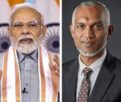Towards a soul-some society

By Prof Surendra Bhatnagar
A blind belief in God has guided man down the ages. And people have fought wars in the name of their god. For the sake of god, they never saw. In defence of the god, the unknown, the argumentative man allowed the sword do the talking for their own versions of God. Man became a mundane crusader of his faith and holy warrior waging bloody wars.
Today, even after so many centuries, man remains true to his original DNA in matters of religion and god. Crusades have become a thing of history but jihad become terrorism seeking to undo the progress and the freedoms progress has brought along with it. The truly religious people, the sheep of God, are scared. The hour of soul searching has come. Godless world of God appears to beckon man to give a go-by to a world of soulless society.
What is a soul? It no more defies a definition. It no longer remains esoteric, otherworldly, or spiritual symbolism steeped in ceremonies Science describes soul as the state of being in action. It is a meta-stable state of being. God, on the other hand, is defined as ‘being at rest’, beyond description and experience. Significantly, God in Hindu mythology is symbolized as Vishnu in sleeping state.
Mind, consciousness, intelligence, and ego maketh a man. In the architecture of the brain, hypothalamus is known to be the seat of emotional mind (sex, hunger, happiness, love, hate, anger). Reticular formation is made responsible for the general awareness as a whole and the cerebrum for all conscious activity and intelligent behaviour of mind. The hippocampus is shown to be crucial for the long-term memories. The cerebellum is described as the region of most of our unconscious and automatic behaviour.
Soul Searching
Well, who controls and coordinates all these functions of the brain. It is the soul. But it has no seat in the brain. In fact, it has no fixed location. It is a non-local meta-stable state of mind -the source of all sentient structures of brain. Philosophers identify it with ego. If mind, in the state of being at rest is God, the soul may be described as being in the state of action.
The general characteristic of soul is freedom. It revolts against all structures and rules; defiance is inherent. When the soul revolts, there is revolution. When the soul revolts, there is evolution
Basic nature of soul is peace and freedom-the two characteristics, it inherits from God. For freedom, it revolts against all kinds of stasis; therefore it is metastable. The freedom it is after is a state of happiness. It is basic to all living-kind.
Look at parrot. In the cage, it remains man’s best companion, mimicking his sounds and speech; but the moment the door is lifted, the bird flies away to a distance from where it is not visible. It shows that birds and animals live for freedom as well. Free-will is an expression and sign of soul. Hence the tendency for defiance of rules and codes. And, resistance to change among all living beings from microbes to man.
We are more familiar with soul and its activities than all the principles of physical sciences. It is the heart of all human activities. Therefore, it is quite natural that the future sociology of man should be based on Soul, which integrates all diverse chords and provides an alternative to the present situation, where man is divided from man on religious and social factors. The divisions breed bitterness and discord. The love and peace are twin functions of soul, which can counter all social strife.
The soul-some society is not based on the principle of duality. It is based on the principle of unity and identity of soul. It does not recognize dialectics, competition and struggles, which are all negative reactions born out of threat to survival of the extant forms. Instead, the soul-some society recognizes the soul’s revolt against codes and laws that stifle soul’ freedom of action and the resultant stress, as the real reason for the social change.
The soul provides the will to survive, will to reproduce, and will to freedom; thereby reason for the evolution of culture and the creativity of mind.
Love and Peace
The world was created in the image of God who happens to be an undivided existence, consciousness, love and peace. The Sacchidananda is the state of impressionless Infinite mind, Shree Meherbaba says in his book Infinite Existence. The state of God is infinite peace, love and happiness. The State of Sadguru is sound sleep in wakefulness, he writes.
Souls or selves (Atmah) are finite conscious entities, having finite love, finite peace and finite happiness, seeking infinite love, infinite peace and infinite happiness (Paramatma). That makes self-sacrifice a necessity at every stage of life. This is real Yajnya. The mutual help and empathy holds the entire fabric of creation as Krishna told Arjuna in Gita.
Barring, peace, love and happiness, all other emotions are reactions. They appear when love and peace are denied and the existence of the individual or society is threatened. The mind gives a violent response when love is denied. The love is, therefore, key to all peace, mental or social. Meherbaba gives it an existential character, when he observes, ‘Love is God’.
Love is the binding thread of a soul-some society, in which all social entities are held as beads.
Mind and brain are both important. Brain has been mapped by scientists. Not mind thus far. It defies science. And man is yet to discover for himself the map for the mind. Brain is an information processing system. Life does not work on information alone; it has feelings as well as cognition. Our mind works with meaning, not information, says Steven Rose in his book, ‘The future of brain’ (2006).
Love (also hate) and peace (also conflict) are root emotions. These lie in the limbic system of human brain and both are under harmonic controls. But information is digital and algorithmic, while feelings are quantum fields. They respond to the flow of emotions. The Atmah hates to be hated. It likes to be loved. It does everything in order to earn love.
Peace is a state of iso-dynamic balance of all forces of mind. It is the seventh shadow of real peace of mind; it is attained by the self-realized souls.
Mind and Man
Mind manifests. It manifests in the three states of existence, matter, energy as well as mind. Therefore, mind matters in the three worlds. Perhaps the simplest definition of mind’s relationship with God and man is given by Meher Baba thus: ‘Mind working is man. Mind working fast is mad. Mind slowed down is Mast (God intoxicated soul) and the mind stopped is God’.
Therefore, God is where mind is not. Where mind does not reach, it totally stops. Thus he reduces all existence to the phenomenology of mind.
Abhinavagupta, a 9th century Kashmiri philosopher, speaks of two states of mind (Iccha Shakti) – Restless Mind, Kshubdha and Resting Mind, Akshubdha.
Kshubdha is the state when passions pacify and mind is at rest; Akshubdha is the state of restive mind, the one at work. It is this latter state which is the cause of creation. The mind measures itself as Triloka (Bhuh-matter, Bhuvah- energy and Swaha- the self),
The Swaha is self or Atman (an Indo-European Automaton). The fourth state of mind is Mahata- the metastable state of non-local, self-cognitive mind -the cause of creation. The self-cognitive mind plays a dual role, that of evolution as well as involution. So upto 7th plane of phenomenological existence, it is mind that is variously working. On the seventh plane the mind stops. It is in the realm of God.
Mind and God
God is the state, which no mind can know or describe. It is only to be, when mind is sacrificed (Manonash). Nearest, in the journey of mind to God, we go up to soul. Hindu temples are not simple prayer halls. They are great visions and ideas carved in stones.
In all temples, there is an animal figure, facing the Godhead. It symbolizes working mind – the will to create – the Jivatma. It also symbolizes the Jivatma who has totally surrendered to the will of God. It is different from Jivatmas or souls like us, who force our will upon God and instead becoming vehicle of his will, make Him to move the way we desire.
The other state where mind is totally at rest -the seat of free will, is the throne of God, located inside the innermost recess -the Garbha griha of the temple.
Meherbaba says God as God does not know what man is. Likewise, man as man does not know the reality of God. In order to know God, one has to be God, Even to know man, God has to incarnate as man and become Godman, the Paigambar -his Messenger or the Son -the Christ.
God cannot be realized by reading scriptures, learning the lives of God-men or even seeing them, as also by practicing and performing rituals and by any kind of intellectual effort, according to the Upanishads, God can only be realized in the moment of truth -the Moksh or salvation which Sufis call as qayamata.
This moment of truth can not be predicted. For anyone. So no amount of discussion will serve any purpose. Discussions at the best help to know own limitations of mind.
While in conversation with Noble laureates Einstein, another noble laureate Rabindranath Tagore remarked even if absolute truth could exist it would be inaccessible to human mind.
‘The present evolution of science’, wrote Ilya Prigogine, himself a noble laureate, ‘is curiously enough running in the direction stated by the great Indian poet’.
The inaccessibility of absolute truth to mankind is attested by Meherbaba, when he says the number of Sadgurus would be a maximum five at any given time. A Sadguru is person who reaches Godhood in his (her) lifetime.
Put differently, presence of God on earth in the form of Sadguru or God-man notwithstanding, the soul will have to still seek its own salvation in a given social, cultural and spiritual milieu. That makes society a greater vehicle for the man’s journey towards inner and outer peace.
-
Book Shelf
-
 Book Review
DESTINY OF A DYSFUNCTIONAL NUCLEAR STATE
Book Review
DESTINY OF A DYSFUNCTIONAL NUCLEAR STATE
- Book ReviewChina FO Presser Where is the fountainhead of jihad?
- Book ReviewNews Pak Syndrome bedevils Indo-Bangla ties
- Book Review Understanding Vedic Equality….: Book Review
- Book Review Buddhism Made Easy: Book Review
- Book ReviewNews Elegant Summary Of Krishnamurti’s teachings
- Book Review Review: Perspectives: The Timeless Way of Wisdom
- Book ReviewNews Rituals too a world of Rhythm
- Book Review Marx After Marxism
- Book Review John Updike’s Terrorist – a review
-
-
Recent Top Post
-
 NewsTop Story
What Would “Total Victory” Mean in Gaza?
NewsTop Story
What Would “Total Victory” Mean in Gaza?
-
 CommentariesTop Story
The Occupation of Territory in War
CommentariesTop Story
The Occupation of Territory in War
-
 CommentariesTop Story
Pakistan: Infighting in ruling elite intensifies following shock election result
CommentariesTop Story
Pakistan: Infighting in ruling elite intensifies following shock election result
-
 CommentariesTop Story
Proforma Polls in Pakistan Today
CommentariesTop Story
Proforma Polls in Pakistan Today
-
 CommentariesTop Story
Global South Dithering Away from BRI
CommentariesTop Story
Global South Dithering Away from BRI
-
 News
Meherabad beckons….
News
Meherabad beckons….
-
 CommentariesTop Story
Hong Kong court liquidates failed Chinese property giant
CommentariesTop Story
Hong Kong court liquidates failed Chinese property giant
-
 CommentariesTop Story
China’s stock market fall sounds alarm bells
CommentariesTop Story
China’s stock market fall sounds alarm bells
-
 Commentaries
Middle East: Opportunity for the US
Commentaries
Middle East: Opportunity for the US
-
 Commentaries
India – Maldives Relations Nosedive
Commentaries
India – Maldives Relations Nosedive
-
AdSense code



















